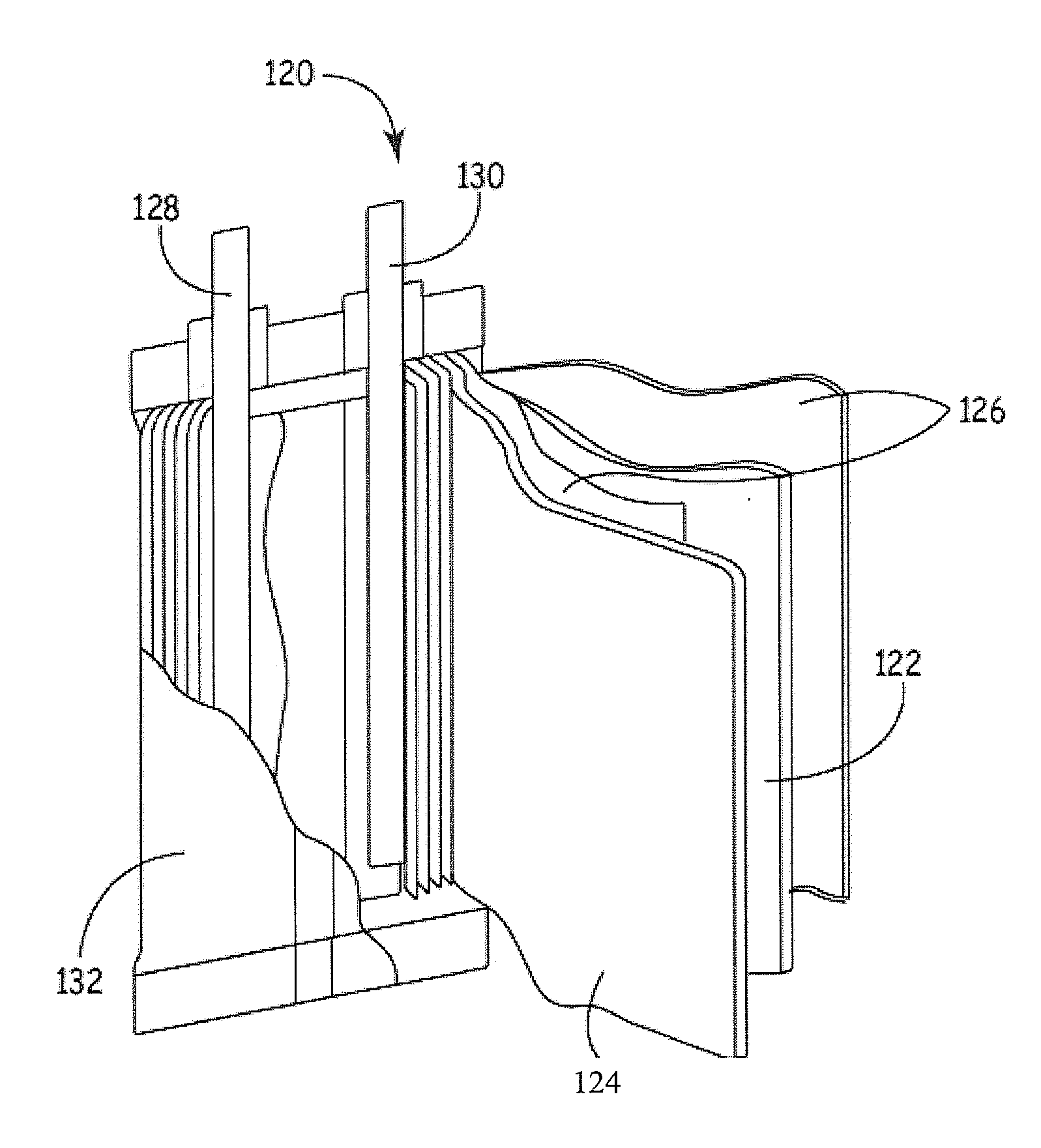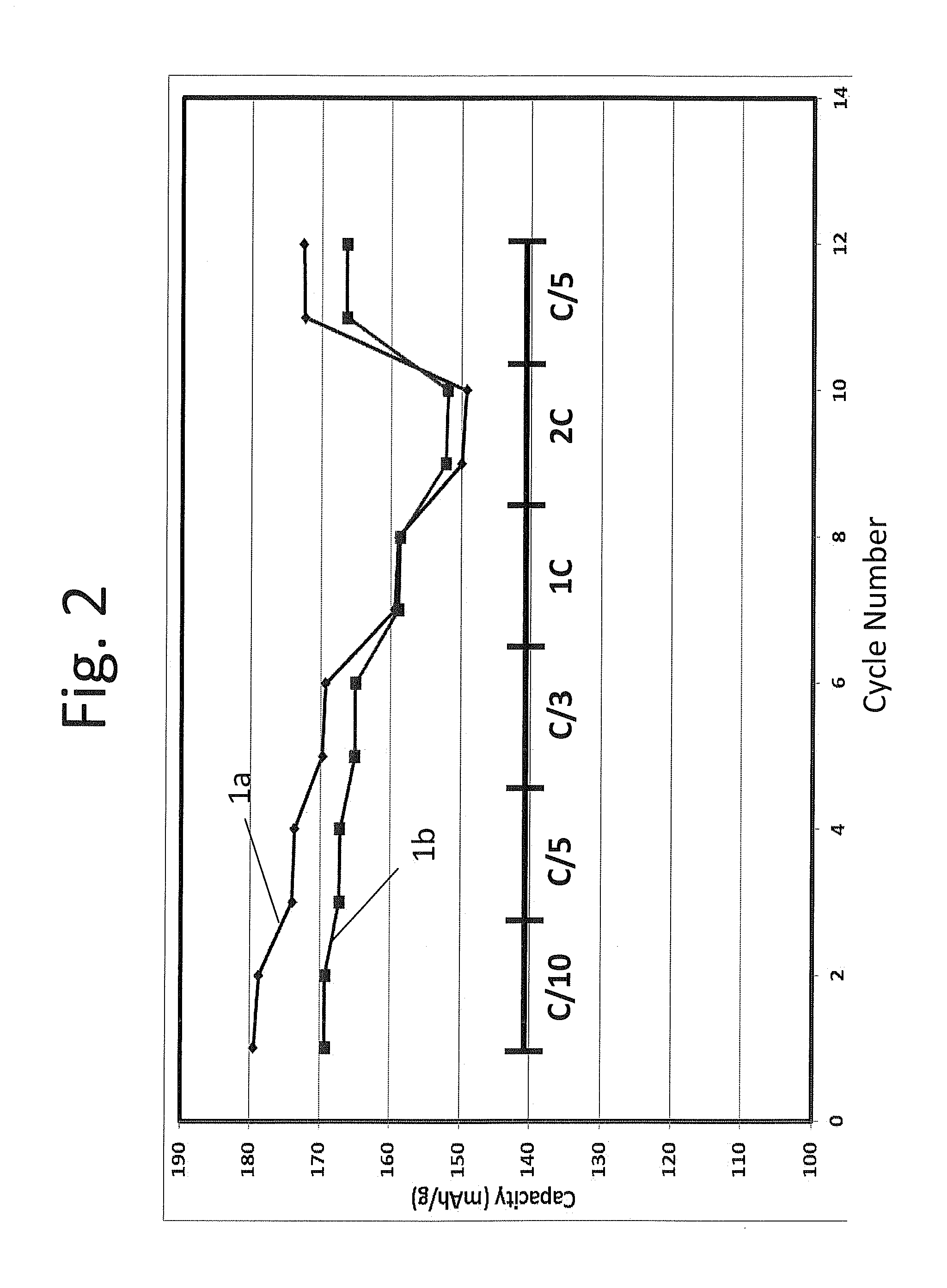High capacity lithium ion battery formation protocol and corresponding batteries
a lithium ion battery, high capacity technology, applied in the direction of secondary cell servicing/maintenance, non-aqueous electrolyte cells, cell components, etc., can solve the problem that the performance of secondary lithium ion batteries generally decreases with increasing the cycle number
- Summary
- Abstract
- Description
- Claims
- Application Information
AI Technical Summary
Benefits of technology
Problems solved by technology
Method used
Image
Examples
example 1
Synthesis of Cathode Materials and Corresponding Electrodes and Batteries
[0111]High capacity cathode materials represented by formula x Li2MnO3.(1−x) LiNiuMnvCowMgyO2, were synthesized using a procedure disclosed in published U.S. patent application 2010 / 0086853A (the '853 application) to Venkatachalam et al. entitled “Positive Electrode Material for Lithium Ion Batteries Having a High Specific Discharge Capacity and Processes for the Synthesis of these Materials”, and published U.S. patent application 2010 / 0151332A (the '332 application) to Lopez et al. entitled “Positive Electrode Materials for High Discharge Capacity Lithium Ion Batteries”, both incorporated herein by reference. The stoichiometry of cathode materials having compositions 1-2 are outlined in Table 1 below.
TABLE 1Mn (% transitionCompositionXMgmetals)10.17500.4520.30.010.51
[0112]Compositions 1 to 2 were then used to construct corresponding positive electrodes, which were in turn used to construct corresponding sets o...
example 2
Evaluation of Battery Performance Under Different Formation Protocols
[0114]Coin cell batteries 1a and 1b formed from composition 1 of example 1 and a graphitic carbon counter electrode were activated under formation protocols 1 and 2 of table 2 above, respectively, i.e. battery 1a was activated at 4.6V and battery 1b was activated at 4.35V. The batteries were cycled at a rate of C / 10 for the 1st and 2nd cycles, at a rate of C / 5 for the 3rd and 4th cycles, at a rate of C / 3 for the 5th and 6th cycles, at 1 C for cycles 7th and 8th, at 2 C for cycles 9th and 10th, and at C / 5 for cycles 11th and 12th, respectively between 4.35-2.5V and the results are plotted in FIG. 2. As shown in FIG. 2, battery 1a activated under formation protocol 1 had higher specific capacity than battery 1b activated under formation protocol 2, except for at rate 2 C. Thus, surprisingly, the battery with only partial activation actually exhibited a greater specific capacity than the battery with full activation a...
example 3
Evaluation of Batteries Based on Differential Capacity Plots
[0115]Coin cell batteries 1c, 1d, 1e, and 1f formed from composition 1 of example 1 and graphitic carbon counter electrode were activated at 4.25V, 4.30V, 4.35V, and 4.5V respectively and tested for differential capacity. The results of differential capacity versus voltage are plotted in FIG. 3. As shown in FIG. 3, especially the enlarged portions 3A and 3B, manganese activity is suppressed when the batteries are cycled up to 4.35V (1e). However, when higher voltage such as 4.5V (1f) are used, there is an increase in Mn activity.
[0116]Coin cell batteries 1g, 1h, and 1j formed from composition 1 of example 1 and lithium foil counter electrode were activated using different formation protocol and procedures and tested for differential capacity. The results of differential capacity versus voltage are plotted in FIG. 4. Specifically, for battery 1g, the battery was charged to 4.4 V in the first cycle and discharged to 2.0 volts...
PUM
| Property | Measurement | Unit |
|---|---|---|
| voltage | aaaaa | aaaaa |
| voltage | aaaaa | aaaaa |
| voltage | aaaaa | aaaaa |
Abstract
Description
Claims
Application Information
 Login to View More
Login to View More - R&D
- Intellectual Property
- Life Sciences
- Materials
- Tech Scout
- Unparalleled Data Quality
- Higher Quality Content
- 60% Fewer Hallucinations
Browse by: Latest US Patents, China's latest patents, Technical Efficacy Thesaurus, Application Domain, Technology Topic, Popular Technical Reports.
© 2025 PatSnap. All rights reserved.Legal|Privacy policy|Modern Slavery Act Transparency Statement|Sitemap|About US| Contact US: help@patsnap.com



